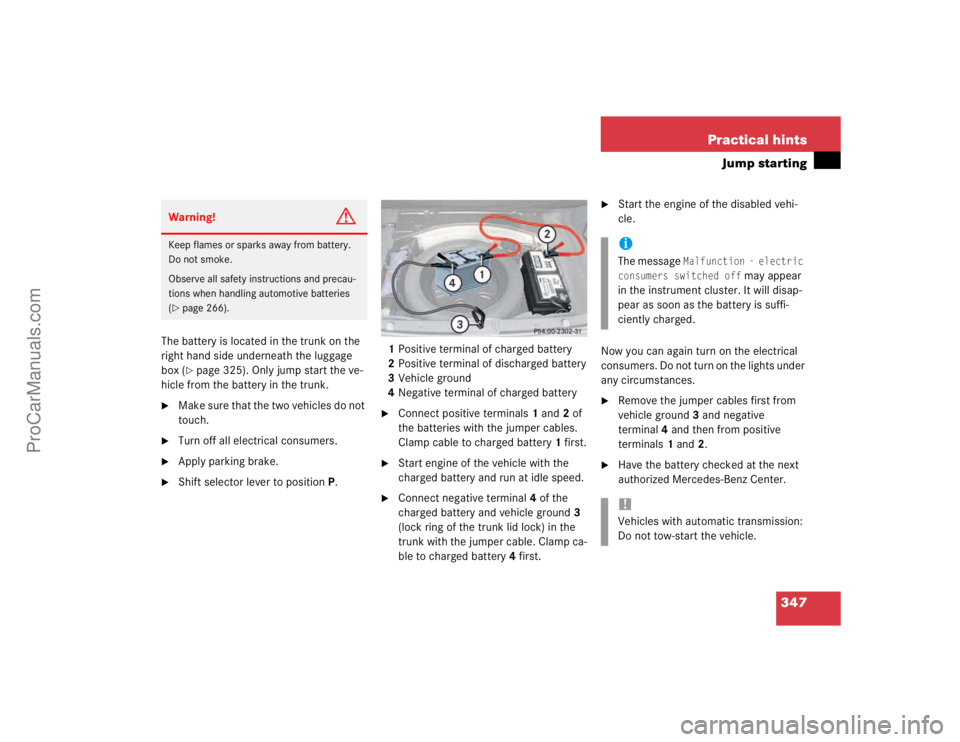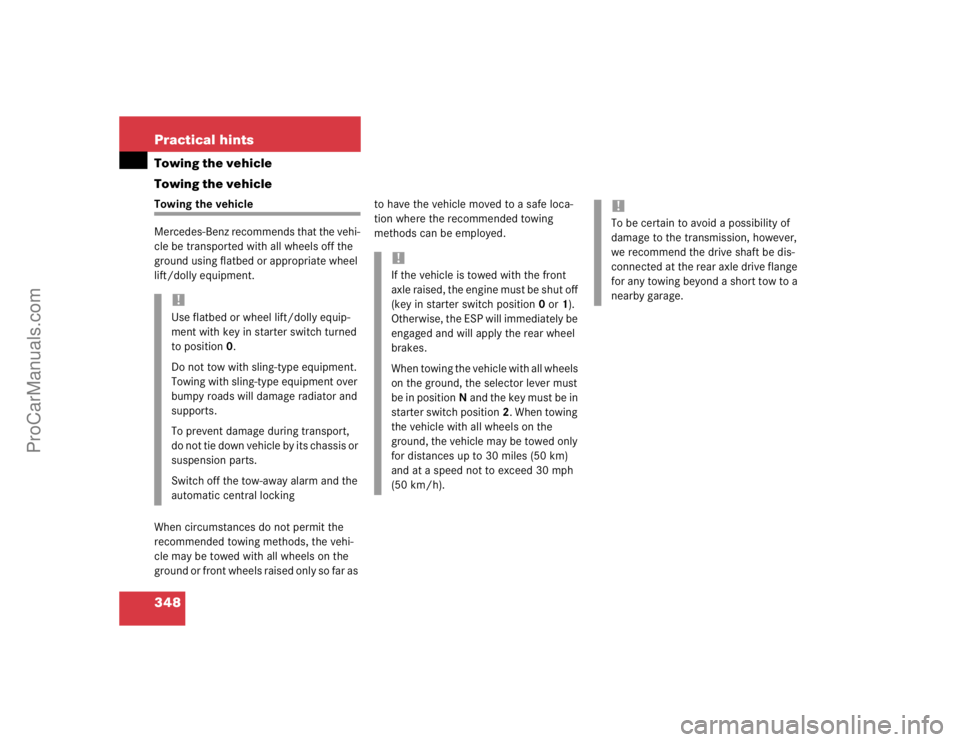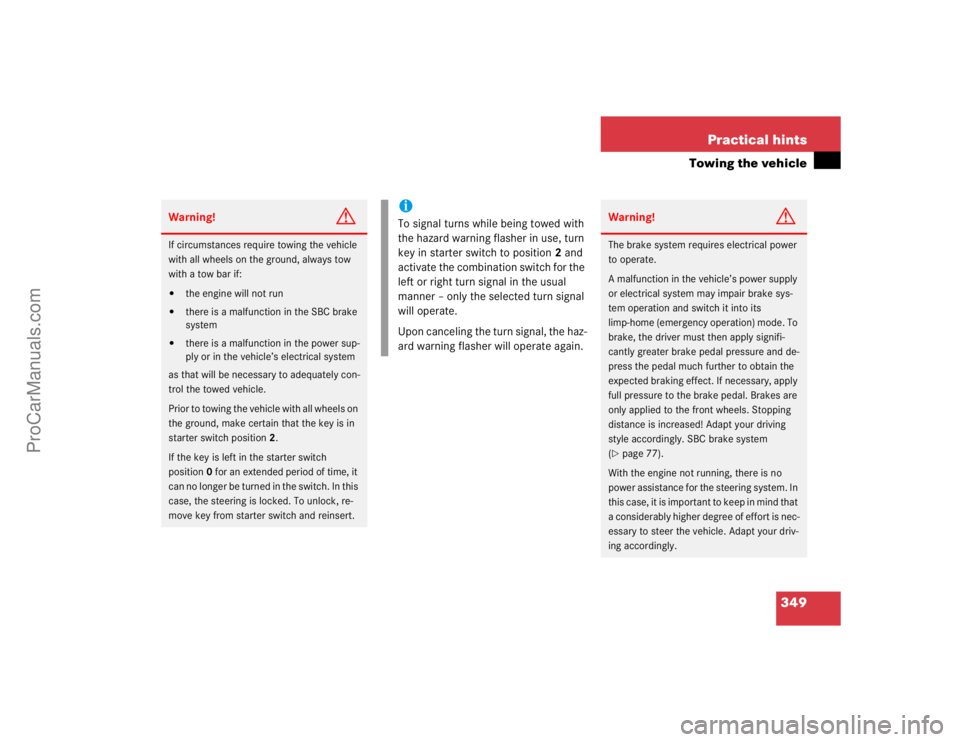Page 346 of 399

346 Practical hintsJump starting
Jump starting
If the battery is discharged, the engine can
be started with jumper cables and the bat-
tery of another vehicle. Observe the follow-
ing:�
Jump starting should only be performed
when the engine and catalytic convert-
er are cold.
�
Do not start the engine if the battery is
frozen. Let the battery thaw out first.
�
Only jump start from batteries with the
same voltage rating.
�
Use only jumper cables with sufficient
cross-section, insulated terminal
clamps and polarity reversal protec-
tion.
Warning!
G
Failure to follow these directions will cause
damage to the electronic components, and
can lead to a battery explosion and severe
injury or death.
Never lean over batteries while connecting
or jump starting, you might get injured.
Battery fluid contains sulfuric acid. Do not
allow this fluid to come in contact with eyes,
skin or clothing. In case it does, immediately
flush affected area with water, and seek
medical help if necessary.
A battery will also produce hydrogen gas,
which is flammable and very explosive. Keep
flames or sparks away from battery, avoid
improper connection of jumper cables,
smoking etc.
Read all instructions before proceeding.
iJumper cables with polarity reversal
protection are available at any autho-
rized Mercedes-Benz Center.
!Jump starting may only be performed
on the main battery installed in the
trunk.
Avoid repeated and lengthy starting at-
tempts.
Do not attempt to start the engine us-
ing a battery quick charge unit.
If the engine does not run after several
unsuccessful starting attempts, have it
checked at the nearest authorized
Mercedes-Benz Center.
Excessive unburned fuel generated by
repeated failed starting attempts may
damage the catalytic converter.
Make sure the jumper cables do not
have loose or missing insulation.
Make sure the cable clamps do not
touch any other metal part while the
other end is still attached to a battery.
ProCarManuals.com
Page 347 of 399

347 Practical hints
Jump starting
The battery is located in the trunk on the
right hand side underneath the luggage
box (
�page 325). Only jump start the ve-
hicle from the battery in the trunk.
�
Make sure that the two vehicles do not
touch.
�
Turn off all electrical consumers.
�
Apply parking brake.
�
Shift selector lever to positionP.1Positive terminal of charged battery
2Positive terminal of discharged battery
3Vehicle ground
4Negative terminal of charged battery
�
Connect positive terminals1 and2 of
the batteries with the jumper cables.
Clamp cable to charged battery1 first.
�
Start engine of the vehicle with the
charged battery and run at idle speed.
�
Connect negative terminal4 of the
charged battery and vehicle ground3
(lock ring of the trunk lid lock) in the
trunk with the jumper cable. Clamp ca-
ble to charged battery4 first.
�
Start the engine of the disabled vehi-
cle.
Now you can again turn on the electrical
consumers. Do not turn on the lights under
any circumstances.
�
Remove the jumper cables first from
vehicle ground3 and negative
terminal4 and then from positive
terminals1 and2.
�
Have the battery checked at the next
authorized Mercedes-Benz Center.
Warning!
G
Keep flames or sparks away from battery.
Do not smoke.
Observe all safety instructions and precau-
tions when handling automotive batteries
(�page 266).
iThe message
Malfunction - electric
consumers switched off
may appear
in the instrument cluster. It will disap-
pear as soon as the battery is suffi-
ciently charged.
!Vehicles with automatic transmission:
Do not tow-start the vehicle.
ProCarManuals.com
Page 348 of 399

348 Practical hintsTowing the vehicle
Towing the vehicleTowing the vehicle
Mercedes-Benz recommends that the vehi-
cle be transported with all wheels off the
ground using flatbed or appropriate wheel
lift/dolly equipment.
When circumstances do not permit the
recommended towing methods, the vehi-
cle may be towed with all wheels on the
ground or front wheels raised only so far as to have the vehicle moved to a safe loca-
tion where the recommended towing
methods can be employed.
!Use flatbed or wheel lift/dolly equip-
ment with key in starter switch turned
to position0.
Do not tow with sling-type equipment.
Towing with sling-type equipment over
bumpy roads will damage radiator and
supports.
To prevent damage during transport,
do not tie down vehicle by its chassis or
suspension parts.
Switch off the tow-away alarm and the
automatic central locking
!If the vehicle is towed with the front
axle raised, the engine must be shut off
(key in starter switch position0 or1).
Otherwise, the ESP will immediately be
engaged and will apply the rear wheel
brakes.
When towing the vehicle with all wheels
on the ground, the selector lever must
be in positionN and the key must be in
starter switch position2. When towing
the vehicle with all wheels on the
ground, the vehicle may be towed only
for distances up to 30 miles (50 km)
and at a speed not to exceed 30 mph
(50 km/h).
!To be certain to avoid a possibility of
damage to the transmission, however,
we recommend the drive shaft be dis-
connected at the rear axle drive flange
for any towing beyond a short tow to a
nearby garage.
ProCarManuals.com
Page 349 of 399

349 Practical hints
Towing the vehicle
Warning!
G
If circumstances require towing the vehicle
with all wheels on the ground, always tow
with a tow bar if:�
the engine will not run
�
there is a malfunction in the SBC brake
system
�
there is a malfunction in the power sup-
ply or in the vehicle’s electrical system
as that will be necessary to adequately con-
trol the towed vehicle.
Prior to towing the vehicle with all wheels on
the ground, make certain that the key is in
starter switch position2.
If the key is left in the starter switch
position0 for an extended period of time, it
can no longer be turned in the switch. In this
case, the steering is locked. To unlock, re-
move key from starter switch and reinsert.
iTo signal turns while being towed with
the hazard warning flasher in use, turn
key in starter switch to position2 and
activate the combination switch for the
left or right turn signal in the usual
manner – only the selected turn signal
will operate.
Upon canceling the turn signal, the haz-
ard warning flasher will operate again.
Warning!
G
The brake system requires electrical power
to operate.
A malfunction in the vehicle’s power supply
or electrical system may impair brake sys-
tem operation and switch it into its
limp-home (emergency operation) mode. To
brake, the driver must then apply signifi-
cantly greater brake pedal pressure and de-
press the pedal much further to obtain the
expected braking effect. If necessary, apply
full pressure to the brake pedal. Brakes are
only applied to the front wheels. Stopping
distance is increased! Adapt your driving
style accordingly. SBC brake system
(�page 77).
With the engine not running, there is no
power assistance for the steering system. In
this case, it is important to keep in mind that
a considerably higher degree of effort is nec-
essary to steer the vehicle. Adapt your driv-
ing accordingly.
ProCarManuals.com
Page 355 of 399
355 Technical data
Spare parts service
Warranty coverage
Identification labels
Layout of poly-V-belt drive
Engine
Rims and tires
Electrical system
Main dimensions
Weights
Fuels, coolants, lubricants etc.
Consumer information
ProCarManuals.com
Page 358 of 399
358 Technical dataIdentification labels
Identification labels1Certification label2Vehicle Identification Number (VIN)3Information label, California version
Vacuum line routing for emission con-
trol system
4Engine number (engraved on engine)
5Emission control label
When ordering spare parts, please specify
vehicle identification and engine numbers.
ProCarManuals.com
Page 360 of 399
360 Technical dataEngine
EngineModel
E 320 (211.065
1)
1The quoted data apply only to the standard vehicle. See an authorized Mercedes-Benz Center for the corresponding data of all special bodies and special equipment.
E 500 (211.070
1)
Engine
112
113
Mode of operation
4-stroke engine, gasoline injection
4-stroke engine, gasoline injection
No. of cylinders
6
8
Bore
3.54 in (89.90 mm)
3.82 in (97.00 mm)
Stroke
3.31 in (84.00 mm)
3.31 in (84.00 mm)
Total piston displacement
195.2 cu.in. (3199 cm
3)
302.9 cu.in. (4966 cm
3)
Compression ratio
10:1
10:1
Output acc. to SAE J 1349
221 hp / 5700 rpm
(165 kW / 5700 rpm)
302 hp / 5600 rpm
(225 kW / 5600 rpm)
Maximum torque acc. to SAE J 1349
232ft.lb/3000rpm
(315 Nm / 3000 rpm)
339ft.lb/2700rpm
(460 Nm / 2700 rpm)
Maximum engine speed
6000 rpm
6000 rpm
Firing order
1-4-3-6-2-5
1-5-4-2-6-3-7-8
Poly-V-belt
7ft 10in (2390mm)
7ft 10in (2390mm)
ProCarManuals.com
Page 366 of 399

366 Technical dataFuels, coolants, lubricants etc.
Fuels, coolants, lubricants etc.CapacitiesVehicle components and their respective
lubricants must match. Therefore use only
brands tested and recommended by us.Please refer to the Factory Approved Ser-
vice Products Pamphlet, or inquire at your
authorized Mercedes-Benz Center.
Model
Capacity
Fuels, coolants, lubricants etc.
Engine with oil filter
E320
E500
8.5 US qt (8.0 l)
8.0 US qt (7.5 l)
Recommended engine oils
Automatic transmission
8.0 US qt (7.5 l)
MB Automatic Transmission Oil
1
1MB part no. 001 989 21 03 10Rear axle
E320
E500
1.06 US qt (1 l)
1.37 US qt (1.3 l)
Hypoid gear oil SAE 85 W 90
Power steering
approx. 1.1 US qt (1.0 l)
MB Power Steering Fluid (Pentosin
CHF 11S)
Front wheel hubs
approx. 3.0 oz (85 g) each
High temperature roller bearing grease
Brake system
0.64 US qt (0.6 l)
MB Brake Fluid (DOT 4+)
Cooling system
E320
E500
approx. 10.7 US qt (10 l)
approx. 11.9 US qt (11.3 l)
MB 325.0 Anticorrosion / Antifreeze
Fuel tank including a reserve of
21.12 US gal (80.0 l)
2.38 US gal (9.0 l)
Premium unleaded gasoline:
Posted Octane 91 (Avg. of 96
RON / 86 MON)
Air conditioner system
R-134a refrigerant and special PAG lu-
bricant oil (never R-12)
ProCarManuals.com